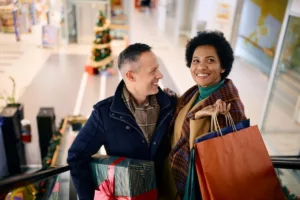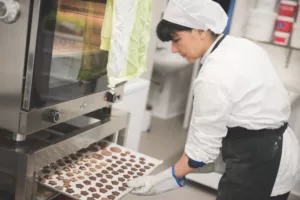- +1 512-591-8295
- [email protected]
- Mon - Fri: 9:00 - 16:00

Very early in my marketing career I learned the importance that seemingly otherwise small psychological factors can play in purchase decisions, which is even more true when you’re looking at making your holiday marketing plans.
One of my earliest full-time marketing jobs was handling the marketing at a shopping mall. You may not realize that most larger malls have a full in-house marketing team, which handles different marketing strategies such as signage that is displayed throughout the mall, visual elements such as some of the displays, year-round events to bring more foot traffic, updating directories and websites – and SO many other aspects of increasing foot traffic for the mall in general and for individual retail stores.
 Our largest responsibility by far was getting ready for holiday shopping. This included weeks of decorating the entire mall common areas for the holidays. We would be in charge of helping inventory the existing decor items, ordering new ones or making repairs when required, coordinating work schedules, and then riding the scissor lift all the way up to the 20′ ceilings to hang the 6′ tall lighted wreaths from the ceiling.
Our largest responsibility by far was getting ready for holiday shopping. This included weeks of decorating the entire mall common areas for the holidays. We would be in charge of helping inventory the existing decor items, ordering new ones or making repairs when required, coordinating work schedules, and then riding the scissor lift all the way up to the 20′ ceilings to hang the 6′ tall lighted wreaths from the ceiling.
We also created acres of fake snow by building up layers of cotton batting for the shapes, covered by strings of white lights, another thinner layer of cotton batting, which was then covered with cases and cases of white plastic snowflakes and a scattering of transparent metallic flakes. Using less flakes wasn’t an option; the best snow always happened when you had enough lights, combined with plentiful application of the different snowflakes – those who used a heavy hand with these pieces always created the most beautiful, sparkly snow scenes. I sort of enjoyed making that snow; it always ended up so pretty even though it took SO much effort. But the effort was worth it to help create the right atmosphere – which is part of marketing.
I remember one year, we were all stressing because Santa’s arrival was always on Black Friday, and the Muzak system had not yet started playing holiday music by the morning of Wednesday before. Not only did all of our decor have to be completed and in place, ready for Santa and his helpers to parade through the mall to his center spot where his photo scene was set up, but we knew the importance of holiday music playing on the speakers throughout the mall. We were able to connect with our music provider and switch to a channel where they already had holiday music playing just in time. (Hey, this was before everything was so digital – we had to make a phone call to get it all straightened out!)
All of our retail partners also understood the importance of having holiday music playing by Black Friday. It’s often said that it’s called Black Friday because for most of the year up to that point – excluding a few other holidays like Mother’s Day and Valentine’s Day – retail businesses operate “in the red” meaning negative gross revenue, and the day after Thanksgiving, being the biggest shopping day of the year, is what let’s them get back “in the black” with a positive gross revenue. Retailers understand the importance of creating an overall mood and atmosphere for their shoppers, so that they will spend more. Shoppers are more likely to make impulse purchases during the holiday season, when they are feeling festive and generous. Retailers know this, and they often use seasonal decorations and special sales to lure shoppers into spending more than they intended.
Oops! There goes your personal budget.
You likely can’t – and probably shouldn’t – be forking out the kind of budget that went into making the pretty and fun holiday decor at the mall. Each of the main pieces were tens of thousands of dollars each – a capital expense that was allocated over at least 10 years but still required large outbound cash flow; all of the smaller items like wreaths and lights added up to at least that much; and the items that needed to be purchased annually because they were removed at the end of season – yards and yards of cotton batting, lights, and flakes for the snow – the cost added up each year. Holiday decor for a full mall was easily over $100K (and that was 20 years ago … inflation!). And then on top add all of the man-hours (and woman-hours) getting it installed and later taken back down … there is a very hefty pricetag on this decor, which lets you understand just how important it was if that amount is allocated to it.
When it comes to holiday shopping, businesses always need to be aware of the psychological triggers that can influence customer behavior.
Creating an ideal shopping environment – no matter whether that’s in person or online – means taking into account things like colors, lighting, and even smells to create a space that is inviting and encourages customers to spend more time – and money – in your store. By understanding the science behind customer behavior, you can create a space designed to boost sales and keep shoppers coming back all season long. Your space needs to look good, smell good, feel good, sound good.
inviting and encourages customers to spend more time – and money – in your store. By understanding the science behind customer behavior, you can create a space designed to boost sales and keep shoppers coming back all season long. Your space needs to look good, smell good, feel good, sound good.
Environment isn’t just about the decor and music – like I spoke about above. You want to look at every possible customer touchpoint, and all five senses. Now, realistically your business will not be able to add atmosphere to every little thing, but you want to have an overall sense of all of the possibilities, so that you can most effectively hone in on those spots that could make the most difference, and ideally things that can encompass more than one sense at a time.
For example, a nice scent may be great, but a scent from a candle with a lightly flickering flame can touch two senses. A display rack of beautiful, holiday-colored scarves touches upon one sense, but if they are also a luxurious material that feels good to the touch, you’ve added another.
Maybe you have seating, which helps rest many senses, and you can combine it with decor around that area that pleases the eyes such as a display of trees and light scent of the forest and apple cider.
You can go even further and integrate some of the ideas below.
When it comes to buying gifts, some people are just naturally better at it than others. But what is it that makes them so good at finding the perfect present? It turns out that there are certain psychological triggers that can make gift giving easier.
For example, understanding the recipient’s personality type can help the giver zero in on a gift that they’ll love. People who are more creative and expressive tend to appreciate things like art supplies or tickets to a show, while those who are more practical may prefer something like a nice piece of jewelry or a new kitchen gadget.
Knowing what kinds of things make the recipient happy is also key. If they love food, a gourmet basket or a subscription to a foodie magazine would be ideal. If they’re into fitness, a new workout outfit or some gear for their favorite sport might be just the thing.
When a prospect enters your store or visits your website, having some “simple gift giving” items front and center can make gift-giving easier for your visitor. If you can take it up a step further, and have them grouped by personality or hobby, you increase the ability for your shoppers to make a quick decision. And any time you can make it easier, you also increase the likelihood of sales by creating an environment in which it’s easy to buy.
What better way to get people in the holiday shopping mood than by appealing to their psychological triggers? By understanding what motivates people to spend money, you can more effectively market to them and get them in the door (or online cart). Here are a few creative ways to trigger holiday shopping behaviors in your customers:
If you’re a retailer, a service business, online or brick and mortar, there are a few things you can do to increase sales during the holiday season.
First, take advantage of psychological buying triggers like fear of missing out (FOMO) and social proof. Use FOMO-inducing language in your ads and make sure your store is well-stocked so that shoppers don’t feel like they’re going to miss out on the perfect gift.
Use social proof by featuring popular items on your website and in your store. You can also offer holiday discounts and promotions to entice shoppers. Here are some ideas that most businesses can implement relatively easily:
In order to take advantage of special deals and discounts, shoppers should be aware of psychological buying triggers. Salespeople often use these triggers to encourage shoppers to buy, and to increase the total cart, and increase average order volume and lifetime value of the customer. Some common psychological buying triggers include fear of missing out, herd mentality, and limited time offers. By understanding these triggers, shoppers can save money and avoid making impulse purchases.
Personalized service and attention to detail are two important psychological buying triggers. By making customers feel special and valued, businesses can increase the likelihood of a sale. This is especially true in the case of luxury items or services, where customers are looking for a VIP experience.
This type of personalized service usually requires higher level of staffing plans, so it may not be feasible or right for all businesses.
Or, you can get creative and offer something like inexpensive but paid appointments with personal shoppers (when the visitor pays, they’re more likely to keep their appointment!)
The convenience and ease of shopping are two of the most important psychological buying triggers for consumers.
In today’s fast-paced world, consumers want to be able to purchase items quickly and easily, without having to go through a lot of hassle. This is why many retailers offer online shopping options and in-store pickup services.
By making it easy for consumers to buy what they want, when they want it, retailers can increase sales and encourage repeat business.
People are more likely to buy products that offer entertainment and socialization opportunities, according to a new study. The research, which was conducted by psychologists at the University of Colorado Boulder, found that people are willing to pay more for products that offer these types of opportunities.
The study’s authors say that the findings could have implications for both marketing and public policy. They suggest that companies might want to consider offering more entertainment and socialization opportunities to customers, and that policymakers might want to consider how these factors can influence consumer behavior (because marketing is important in that world as well).
 You may need to get creative with how you can combine these opportunities. One idea that is very common is how retail book stores will host an author signing. The cost of that may be prohibitive to smaller local book sellers, in which case you may want to consider having a local author.
You may need to get creative with how you can combine these opportunities. One idea that is very common is how retail book stores will host an author signing. The cost of that may be prohibitive to smaller local book sellers, in which case you may want to consider having a local author.
Another example that comes quickly to my mind is how Park West Galleries – which runs the art sales on multiple cruise lines – has opportunities for collectors of specific artists to attend meet and greets with the artist. At least, that’s what they’ve said … I’ve never bought enough art to be invited lol (hey, I am an artist; I meet and greet myself every day!)
Simple client happy hours are a great way to offer some socialization opportunities, especially throughout the holidays. Even nonprofits can take advantage of this idea by holding an open house for their board members and the community to come connect with their mission during the holidays.
Our experiences and memories play a big role in our purchasing decisions. We are more likely to buy products that remind us of happy times or that we associate with positive experiences.
On the other hand, we may avoid products that remind us of negative experiences.
Marketing experts use this knowledge to create advertising campaigns and store layouts that trigger positive memories and associations, leading us to spend more money.
 We encouraged the owners of the cookie shop at the mall to use this psychological trigger by simply using a fan to help blow the smell of the baking cookies a bit further out into the mall than it might naturally travel, since most people associate good memories with the scent of fresh-baked cookies. This is also why real estate agents will sometimes bake a quick batch of cookies right before an open house – it serves two purposes: a snack for prospective buyers while triggering happy memories of a cozy home.
We encouraged the owners of the cookie shop at the mall to use this psychological trigger by simply using a fan to help blow the smell of the baking cookies a bit further out into the mall than it might naturally travel, since most people associate good memories with the scent of fresh-baked cookies. This is also why real estate agents will sometimes bake a quick batch of cookies right before an open house – it serves two purposes: a snack for prospective buyers while triggering happy memories of a cozy home.
In fact, scent is one of the quickest ways to trigger memories.
According to Discovery.com: “Scents bypass the thalamus and go straight to the brain’s smell center, known as the olfactory bulb. The olfactory bulb is directly connected to the amygdala and hippocampus, which might explain why the smell of something can so immediately trigger a detailed memory or even intense emotion.” You can find plenty of research on this phenomenom from institutions such as Harvard and many others.
There’s nothing quite like the feeling of giving to others. Whether it’s a small act of kindness or a more significant gesture, giving provides a unique sense of connection with others.
And it turns out that this feeling of connection is one of the most powerful psychological buying triggers. According to studies, when we give to others, our brain releases oxytocin, the so-called “love hormone” that helps us bond with others. This release of oxytocin not only makes us feel good, but it also makes us more likely to spend money.
This is one reason companies like Toms that have a social component are so successful. You can foster this type of connection in your business as well; there are tons of creative ways to do so. You can have shoppers round up to donate to a cause, hold special sales that are fundraisers for causes (like Kendra Scott jewelry is well known for doing). Even something as simple as having a fishbowl to accept donations can be effective.
 Six out of 10 Americans will travel an extra 10 minutes to make a purchase that supports a cause they care about, and nearly 3 out of 4 are even willing to pay more.
Six out of 10 Americans will travel an extra 10 minutes to make a purchase that supports a cause they care about, and nearly 3 out of 4 are even willing to pay more.
If you aren’t sure of the most effective ways to leverage charitable giving as a marketing tool during the holidays, you could participate in Giving Tuesday, or try connecting directly with your charity of choice and brainstorming together, although they almost always appreciate an unrestricted cash gift.
By understanding how the mind of a shopper works, you can effectively market your business online and increase sales during the holidays.
Did you know … you can book a single Fractional CMO (Chief Marketing Officer) consultation appointment if you would like high-level help strategizing through your options.
Get solid marketing strategies, designed for entrepreneurs on the track to 7-figures and beyond, right in your inbox.

This website uses cookies to ensure you get the best experience on our website. By continuing to use the website, you agree to our use of cookies. We do not share or sell your information. More info
